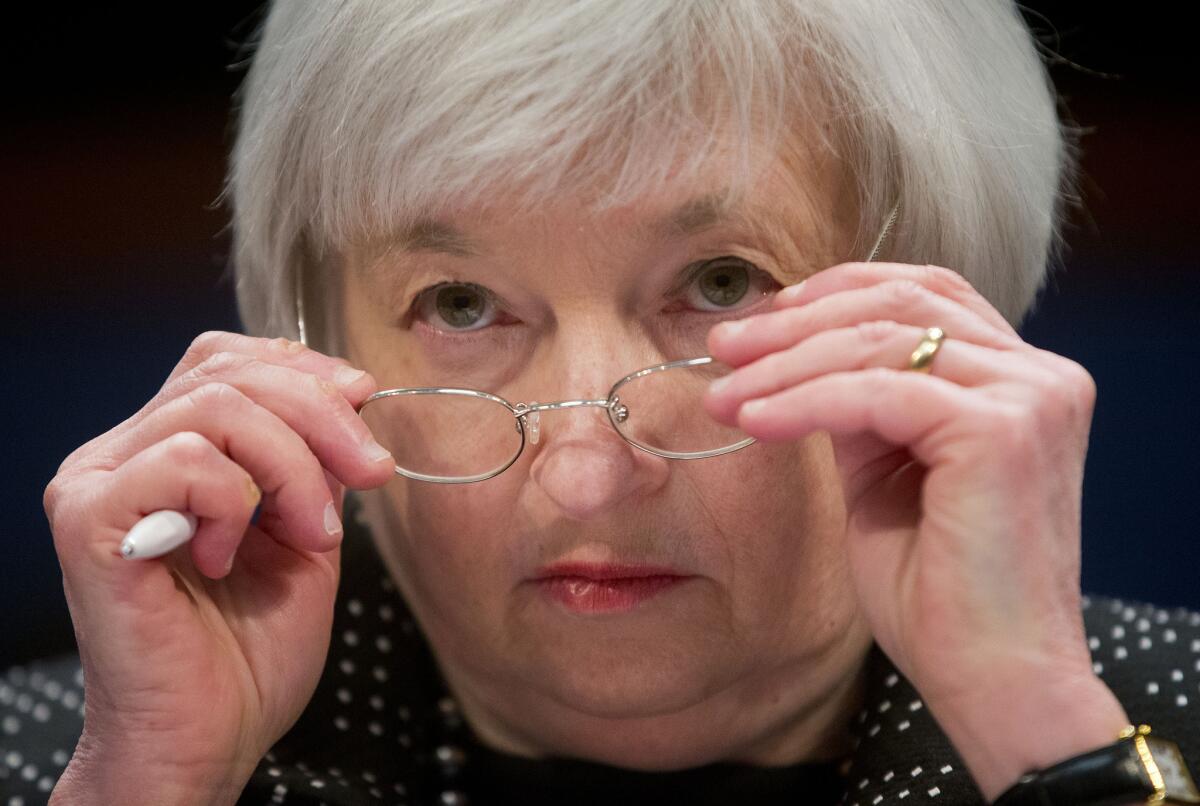Fed raises benchmark interest rate for first time in nearly 10 years

Federal Reserve Chairwoman Janet L. Yellen removes her glasses as she testifies on Capitol Hill on Feb. 25.
- Share via
The Federal Reserve on Wednesday raised its benchmark short-term interest rate for the first time in 9 1/2 years, providing a long-awaited vote of confidence for the recovery from the Great Recession by beginning to remove the last of the central bank’s extraordinary steps to boost economic growth.
Seven years to the day after lowering the rate to near zero, members of the policymaking Federal Open Market Committee edged it up 0.25 percentage point.
The move ended months of speculation about when the so-called federal funds rate, which affects terms for consumer and business loans, would begin inching back toward normal.
In a statement approved by a unanimous vote, Fed officials said there “has been considerable improvement in labor market conditions this year” and that they expect low inflation to rise in the coming months.
Central bank policymakers said they acted now in part because it takes time for changes in the interest rate to affect the economy.
But they promised to go slow with future rate hikes, slowly reducing the stimulus.
“The committee expects that economic conditions will evolve in a manner that will warrant only gradual increases in the federal funds rate,” the statement said.
Join the conversation on Facebook >>
The rate “is likely to remain, for some time,” below the longer-run level of about 3.5%, it said.
Fed policymakers said they would watch economic data to determine “the timing and size” of future rate hikes.
A majority of the 17 members of the Open Market Committee expect the rate to rise to at least 1.375% at the end of 2016, according to projections released Wednesday.
That still would be extremely low by historical standards.
If the Fed sticks to small, 0.25-percentage-point moves, that would mean four more rate hikes next year.
The rate would rise to 2.4% by the end of 2017 and 3.3% by the end of 2018, according to the median projection of the Fed policymakers.
To put that in context, the rate was 5.25% in 2006 when the Fed began lowering it in response to the economic slowdown that led to the Great Recession.
Fed Chairwoman Janet L. Yellen and other central bank policymakers have signaled in recent weeks they were ready to act, preparing financial markets for a move that some fear could slow economic growth by starting to choke off the flow of low-cost money that has helped fuel the recovery.
But Fed policymakers cited economic improvements on Wednesday.
When the Fed lowered the rate to near zero in December 2008, the economy was losing 700,000 jobs a month. For the last year, the economy has added about 237,000 jobs a month.
Fed officials said in their statement Wednesday that “ongoing job gains and declining unemployment” recently shows the further improvement in the labor market they had said was necessary for a rate hike.
The unemployment rate in November was 5% -- half the high it reached in late 2009 in the aftermath of the Great Recession.
But wage growth has been sluggish, although it has shown signs of picking up in recent months. And inflation remains well below the Fed’s 2% annual target, largely because of the steep decline in oil prices that began last year.
Fed policymakers said they expect the downward pressures of oil prices to be temporary. But in a nod to concerns that increasing the interest rate will push inflation down, the statement said committee members will “carefully monitor” inflation developments.
Fed policymakers slightly upgraded their forecast for economic growth next year. The median estimate called for 2.4% growth compared with 2.3% in the September projection.
They also were a bit more optimistic about the labor market, forecasting that the unemployment rate would be 4.7% at the end of next year compared with a 4.8% projection in September.
Inflation will pick up significantly next year, to 1.6% from this year’s estimated 0.4%, Fed policymakers said. But the 2016 figure is 0.1 percentage point less than the September forecast and still below the Fed’s annual 2% target.
Inflation will not reach 2% until the end of 2018, Fed policymakers projected.
ALSO
Southern California home sales edge up in November
Self-driving cars must have driver behind the wheel, California says
Congress reaches sweeping deal on spending, oil export ban and specialty tax breaks
More to Read
Inside the business of entertainment
The Wide Shot brings you news, analysis and insights on everything from streaming wars to production — and what it all means for the future.
You may occasionally receive promotional content from the Los Angeles Times.










